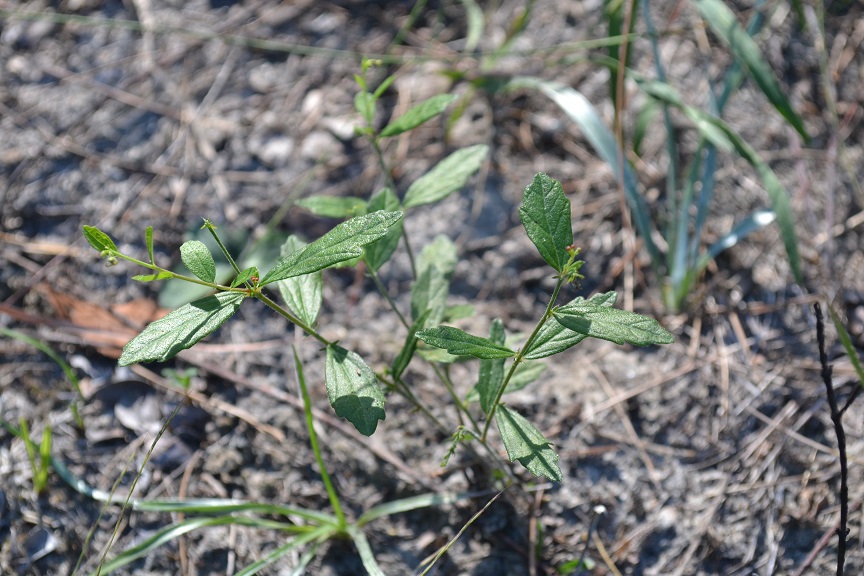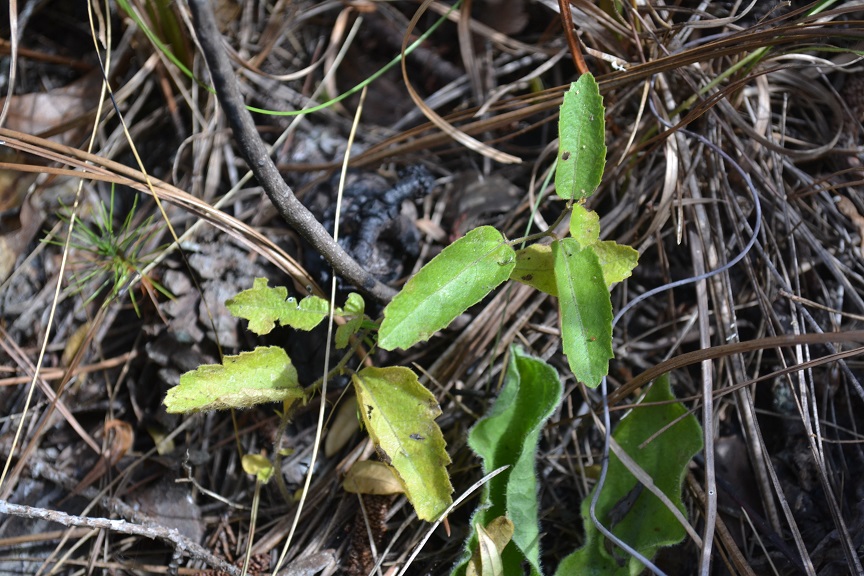Difference between revisions of "Tragia urens"
Lsandstrum (talk | contribs) |
Lsandstrum (talk | contribs) |
||
| Line 31: | Line 31: | ||
==Ecology== | ==Ecology== | ||
===Habitat=== <!--Natural communities, human disturbed habitats, topography, hydrology, soils, light, fire regime requirements for removal of competition, etc.--> | ===Habitat=== <!--Natural communities, human disturbed habitats, topography, hydrology, soils, light, fire regime requirements for removal of competition, etc.--> | ||
| − | In the Coastal Plain in Florida and Georgia, ''T. urens'' has been found in sand of open woodlands, pine uplands, fallow fields, annually burned pineland, sandhills, sand pine scrub, longleaf pine/wiregrass communities, and open pine savannas. <ref name="FSU Herbarium">Florida State University Robert K. Godfrey Herbarium database. URL: [http://herbarium.bio.fsu.edu http://herbarium.bio.fsu.edu]. Last accessed: July 2015. Collectors: Loran C. Anderson, R. A. Norris, Robert K. Godfrey, Andre F. Clewell, Chris Cooksey, M. Davis, J. M. Kane, R. Komarek, Lisa Keppner, Cecil R Slaughter, Annie Schmidt. States and Counties: Florida: Duval, Franklin, Gadsden, Jackson, Leon, Osceola, Wakulla, Washington. Georgia: Thomas. Compiled by Tall Timbers Research Station and Land Conservancy.</ref> Associated species include longleaf pine, sand pine, and wiregrass. <ref name="FSU Herbarium"/> ''T. urens'' responds positively to agricultural-based soil disturbance in South Carolina coastal plain communities. This marks it as a possible indicator species for post-agricultural woodland.<ref>Brudvig, L.A., E Grman, C.W. Habeck, and J.A. Ledvina. (2013). Strong legacy of agricultural land use on soils and understory plant communities in longleaf pine woodlands. Forest Ecology and Management 310: 944-955.</ref> | + | In the Coastal Plain in Florida and Georgia, ''T. urens'' has been found in sand of open woodlands, pine uplands, fallow fields, annually burned pineland, sandhills, sand pine scrub, longleaf pine/wiregrass communities, and open pine savannas. <ref name="FSU Herbarium">Florida State University Robert K. Godfrey Herbarium database. URL: [http://herbarium.bio.fsu.edu http://herbarium.bio.fsu.edu]. Last accessed: July 2015. Collectors: Loran C. Anderson, R. A. Norris, Robert K. Godfrey, Andre F. Clewell, Chris Cooksey, M. Davis, J. M. Kane, R. Komarek, Lisa Keppner, Cecil R Slaughter, Annie Schmidt. States and Counties: Florida: Duval, Franklin, Gadsden, Jackson, Leon, Osceola, Wakulla, Washington. Georgia: Thomas. Compiled by Tall Timbers Research Station and Land Conservancy.</ref> Associated species include longleaf pine, sand pine, and wiregrass. <ref name="FSU Herbarium"/> ''T. urens'' responds positively to agricultural-based soil disturbance in South Carolina coastal plain communities. This marks it as a possible indicator species for post-agricultural woodland.<ref>Brudvig, L.A., E Grman, C.W. Habeck, and J.A. Ledvina. (2013). Strong legacy of agricultural land use on soils and understory plant communities in longleaf pine woodlands. Forest Ecology and Management 310: 944-955.</ref><ref>Brudvig, L.A., J.L. Orrock, E.I. Damschen, C.D. Collins, P.G. Hahn, W.B. Mattingly, J.W. Veldman, and J.L. Walker. (2014). Land-Use History and Contemporary Management Inform an Ecological Reference Model for Longleaf Pine Woodland Understory Plant Communities. PLoS ONE 9(1): e86604.</ref> |
===Phenology=== <!--Timing off flowering, fruiting, seed dispersal, and environmental triggers. Cite PanFlora website if appropriate: http://www.gilnelson.com/PanFlora/ --> | ===Phenology=== <!--Timing off flowering, fruiting, seed dispersal, and environmental triggers. Cite PanFlora website if appropriate: http://www.gilnelson.com/PanFlora/ --> | ||
Revision as of 18:32, 9 July 2019
| Tragia urens | |
|---|---|

| |
| Photo by Kevin Robertson | |
| Scientific classification | |
| Kingdom: | Plantae |
| Division: | Magnoliophyta – Flowering plants |
| Class: | Magnoliopsida – Dicotyledons |
| Order: | Euphorbiales |
| Family: | Euphorbiaceae |
| Genus: | Tragia |
| Species: | T. urens |
| Binomial name | |
| Tragia urens L. | |

| |
| Natural range of Tragia urens from USDA NRCS Plants Database. | |
Common names: Wavyleaf noseburn, Southeastern noseburn
Contents
Taxonomic notes
Synonym: Tragia linearifolia Elliott
Description
"Monoecious, perennial, rhizomatous herbs, armed with stinging trichomes. Leaves alternate, stipulate. Racemes axillary or terminal, or both, lowest 1 or 2 flowers pistillate, the upper staminate. Flowers greenish or purplish; petals absent; staminate flowers with 3-5 sepals and 2 or 3 stamens; pistillate with 3-8 sepals and 3 stigmas. Capsule 3-locular, 4-5 mm long, 7-8 mm in diam., each locule 1-seeded. Seeds light brown with darker mottling, or entirely dark brown, ovoid, 3-3.5 mm long; caruncle obsolete." [1]
"Plant 2-5 dm tall, freely branched. Leaves narrowly elliptic to oblanceolate or linear, 2-10 cm long, 0.2-2 cm wide, irregularly serrate, undulate or entire, base cuneate to attenuate; petioles 1-3 mm long. Racemes short or elongate, 0.3-12 cm long." [1]
Distribution
Ecology
Habitat
In the Coastal Plain in Florida and Georgia, T. urens has been found in sand of open woodlands, pine uplands, fallow fields, annually burned pineland, sandhills, sand pine scrub, longleaf pine/wiregrass communities, and open pine savannas. [2] Associated species include longleaf pine, sand pine, and wiregrass. [2] T. urens responds positively to agricultural-based soil disturbance in South Carolina coastal plain communities. This marks it as a possible indicator species for post-agricultural woodland.[3][4]
Phenology
T. urens has been observed flowering in April, May, and July and fruiting May through September.[2][5]
Seed dispersal
This species is thought to be dispersed by ants and/or explosive dehiscence. [6]
Conservation and management
Cultivation and restoration
Photo Gallery
References and notes
- ↑ 1.0 1.1 Radford, Albert E., Harry E. Ahles, and C. Ritchie Bell. Manual of the Vascular Flora of the Carolinas. 1964, 1968. The University of North Carolina Press. 665. Print.
- ↑ 2.0 2.1 2.2 Florida State University Robert K. Godfrey Herbarium database. URL: http://herbarium.bio.fsu.edu. Last accessed: July 2015. Collectors: Loran C. Anderson, R. A. Norris, Robert K. Godfrey, Andre F. Clewell, Chris Cooksey, M. Davis, J. M. Kane, R. Komarek, Lisa Keppner, Cecil R Slaughter, Annie Schmidt. States and Counties: Florida: Duval, Franklin, Gadsden, Jackson, Leon, Osceola, Wakulla, Washington. Georgia: Thomas. Compiled by Tall Timbers Research Station and Land Conservancy.
- ↑ Brudvig, L.A., E Grman, C.W. Habeck, and J.A. Ledvina. (2013). Strong legacy of agricultural land use on soils and understory plant communities in longleaf pine woodlands. Forest Ecology and Management 310: 944-955.
- ↑ Brudvig, L.A., J.L. Orrock, E.I. Damschen, C.D. Collins, P.G. Hahn, W.B. Mattingly, J.W. Veldman, and J.L. Walker. (2014). Land-Use History and Contemporary Management Inform an Ecological Reference Model for Longleaf Pine Woodland Understory Plant Communities. PLoS ONE 9(1): e86604.
- ↑ Nelson, G. PanFlora: Plant data for the eastern United States with emphasis on the Southeastern Coastal Plains, Florida, and the Florida Panhandle. www.gilnelson.com/PanFlora/ Accessed: 14 DEC 2016
- ↑ Kirkman, L. Katherine. Unpublished database of seed dispersal mode of plants found in Coastal Plain longleaf pine-grasslands of the Jones Ecological Research Center, Georgia.

